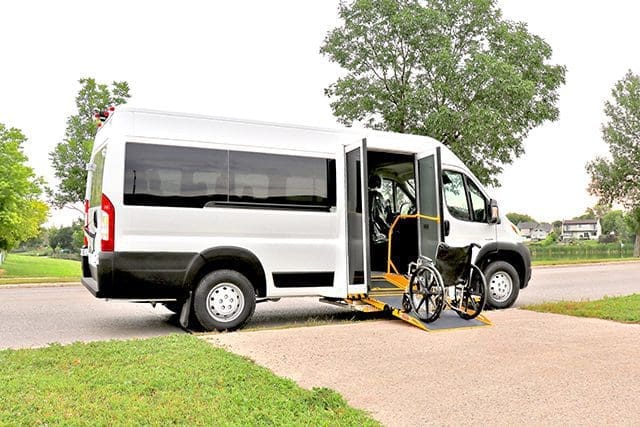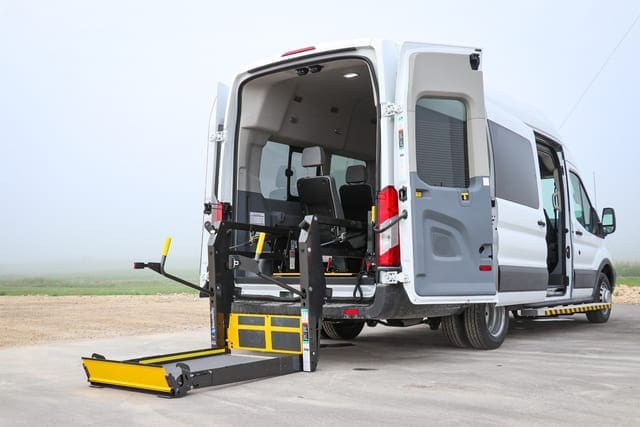Mobile health is growing fast in Canada. In some rural areas, over 40% of healthcare visits now happen outside of traditional clinics.
One big reason? Access. When people can’t get to care, care needs to come to them.
That’s where mobile blood draw vehicles come in. But here’s the big question:
Do you go with a van or an SUV?
You might be:
- Using a regular SUV now and running out of room
- Carrying supplies in and out at every stop
- Struggling to reach more patients
- Worrying about safety for staff and clients
That’s a lot to juggle. The right setup can make your work easier and more effective.
At MoveMobility, we’ve helped organizations like yours across Canada launch safe, comfortable mobile medical units. We’ve been manufacturing customized medical vans for over two decades, and this guide is all about helping you choose what’s best for your team.
Here’s what we’ll cover:
- SUV vs. van: Pros and cons for mobile blood draw services
- When an SUV makes sense
- When a RAM Promaster van is a better fit
We’ll help you pick the right path so your program runs smoother, safer, and stronger.
Mobile blood draw vehicles: What are the pros and cons of an SUV?
Using an SUV for mobile blood draw services means turning a standard sport utility vehicle, such as a Chevy Suburban or Ford Explorer, into a mobile workspace.
You won’t find a built-in exam room or medical layout. Instead, these vehicles often act more like a transportation tool than a full-on clinic. Staff carry supplies in and out at each stop and use space creatively to serve patients.
It works, but it also comes with some trade-offs. Let’s take a closer look at the advantages and disadvantages.
Pros of using an SUV for mobile blood draw services
1. Easy to drive: SUVs drive similarly to regular cars. They’re ideal for busy city streets, tight parking, or rural roads with rough terrain.
2. Lower upfront cost: Buying an SUV off the lot usually costs less than a fully outfitted vehicle. There’s no major conversion work needed.
3. Good for small-scale programs: An SUV can be enough if you’re just starting out, doing outreach in low-volume areas, or only drawing blood from one or two people per stop.
4. Blends in: SUVs don’t scream “medical vehicle.” This helps if you want to keep a low profile or avoid drawing attention in certain areas.
Cons of using an SUV for mobile blood draw services
1. No dedicated clinical space: There’s no private area for blood draws. That often means drawing blood inside a client’s home, on a porch, or in a parking lot. This can feel uncomfortable and limits your control over the environment.
2. Limited storage: There’s not much space for coolers, sharps containers, PPE, and other gear. That means constantly loading and unloading supplies, which takes time and effort.
3. Not built for patient comfort: There’s no dedicated mobile blood draw chair or privacy screen. Patients may feel uneasy getting blood drawn in the backseat or outside the vehicle, which can make the process harder for everyone.
4. Harder to stay organized: Tools and supplies can get messy quickly when everything is packed into a small trunk or back seat. It’s easy to misplace things or run out of something mid-visit.
5. No handwashing or sanitation setup: SUVs don’t come with sinks, water tanks, or infection control features, which can increase risks to both staff and patients.
6. Less professional appearance: For some communities or partner organizations, an SUV doesn’t look as official and trustworthy as other types of mobile blood draw vehicles. An SUV may not deliver the same impact or confidence.
Bottom line:
SUVs can work for mobile blood draws, especially for new or small programs. But they come with space, privacy, and safety limitations. It might not be enough if you’re planning to grow your services in the future.
Next up, let’s look at what vans, like the RAM Promaster, bring to the table.
What are the pros and cons of a RAM Promaster Mobile Clinic Van for mobile blood draw services?
A RAM Promaster Mobile Clinic Van for mobile blood draw services is a fully customized medical vehicle. It’s not just a van with supplies in the back. It’s a self-contained clinic on wheels built to meet the needs of healthcare workers in the field.
Instead of carrying equipment into homes or offices, you can bring people directly into the van for their blood draw. This setup boosts safety, privacy, and professionalism.
Pros of using a RAM Promaster Mobile Clinic Van for mobile blood draw services
1. Draw blood right in the van: You don’t have to haul coolers, kits, or sharp containers into homes or buildings. Everything you need is inside the van. Patients walk in, get their draw, and walk out.
2. Better infection control: You can keep things clean and consistent. You’re not dealing with dusty living rooms, cluttered offices, or unpredictable environments. You have full control of the space.
3. Custom medical features
Your van can include:
- Handwashing sink
- Fridge for samples
- Secure cabinetry for supplies
- Phlebotomy chair designed for blood draws
- Small office desk for paperwork or laptops
This turns your van into a mobile clinic that works like a real workspace.
4. Accessible for people with mobility challenges: You can add a wheelchair-accessible ramp to make it easier for people using walkers, canes, or wheelchairs to get inside. This will help you serve more patients with dignity and ease.
5. Private and discreet for patients: Some people feel nervous or embarrassed getting blood drawn at home or in public areas. A van offers privacy and a professional setting that helps patients feel more comfortable.
6. More professional and trustworthy look: To the public, a branded van with medical features looks reliable. It shows you’re serious, safe, and official.
7. Easier for staff: No more back-and-forth trips carrying gear. Everything stays in the vehicle, which saves time and reduces stress..
Cons of using a RAM Promaster van for mobile blood draw services
1. Higher initial investment: A customized van costs more upfront than buying an SUV. You’re paying for a vehicle and a medical build-out.
2.Bigger vehicle to drive: It’s a van, not a short SUV. Staff might need training or time to get used to driving and parking it, especially in tighter areas.
3. May not be needed for very small programs: If you’re just starting out with one or two draws a day, a van might feel like too much for now.
When should you choose an SUV for mobile blood draw services?
Some organizations make an SUV work, but it all depends on your setup and goals.
Here’s when it might be the better choice for your team:
- You already have access to indoor spaces: If your organization partners with clinics, shelters, or community centers where you can set up indoors, you won’t need a mobile clinic built into the vehicle.
- You need a flexible, all-purpose vehicle: SUVs can be used for more than just healthcare. If your team also uses the vehicle for work trips or community outreach, it may offer the flexibility you’re looking for.
- You have a low patient volume: If your team draws blood from only a few people daily, you don’t need a large setup. A simple SUV can do the job.
- You’re working with a limited budget: SUVs are usually less expensive than RAM Promaster vans. If you’re launching a new program or need a stopgap solution, this can be a smart first step.
- You don’t need to carry bulky medical equipment: If your team only needs light supplies like vials, gloves, and kits, an SUV has enough space without being too large to manage.
When should you choose a RAM Promaster Mobile Clinic Van for mobile blood draw services?
Think of it like a carpenter choosing tools. Sure, you can use a hammer to put in nails, but a nail gun makes the job faster, cleaner, and easier. That’s what a RAM Promaster Mobile Clinic Van does for mobile blood draws. It’s built for the job and helps your team work better and smarter.
Here’s when a Mobile Clinic Van is the right choice:
- You want to keep blood draws sanitary and inside: If you don’t want to carry blood draw supplies in and out of buildings, a van lets you do everything inside. This keeps your equipment clean and cuts down on mess or mistakes.
- Your team works with many patients every day: If you draw blood from lots of people daily, having a van gives you room to work smoothly without feeling too cramped. It helps you stay organized and saves time.
- You need to carry bigger or special equipment: If your work requires more than basic supplies, like Welch-Allyn equipment or other medical gear, the van’s space can safely handle it all.
- Accessibility is important to your program: If your patients include people with mobility challenges, vans can be customized with ramps or lifts. This makes your service welcoming and easy to use.
- You want to customize your workspace: A Mobile Clinic Van offers numerous customization options. You can add sinks, fridges, and a comfortable blood draw chair. This matters if your team needs a well-equipped space to do quality work.
- You want room to grow over the long term: If you plan to expand your services or see more patients over time, a van gives you space to do it. It’s like picking the right tool that grows with your team, not one you’ll outgrow in a year.
Explore mobile blood draw vehicle options with MoveMobility
You came to this article because you’re looking for the best vehicle to support your mobile blood draw services. Choosing between an SUV and a RAM Promaster Mobile Clinic Van is a big decision, especially if you’re just starting out or looking to expand.
Here’s what you learned:
- SUVs are suitable for organizations with access to indoor spaces, lower patient volumes, and limited budgets.
- RAM Promaster Mobile Clinic Vans offer a customizable, all-in-one solution for conducting blood draws directly inside the vehicle, accommodating higher patient volumes, and providing accessibility features.
At MoveMobility, we specialize in designing and manufacturing mobile medical vans tailored to your organization’s specific needs. We understand the challenges healthcare providers face and are committed to delivering solutions that enhance your service delivery. If you have questions or need assistance choosing the right vehicle, click the button below to talk to a mobility expert.
If you’re not ready to speak with a mobility expert yet, we have additional resources available to help you learn more about mobile medical solutions.
Start by checking out our article or video below on what you can expect to pay for a Mobile Clinic Van.
You might also be interested in our articles on how vans compare to other vehicles like buses or RVs for mobile blood draw services. Read through our two articles on that to learn more.







